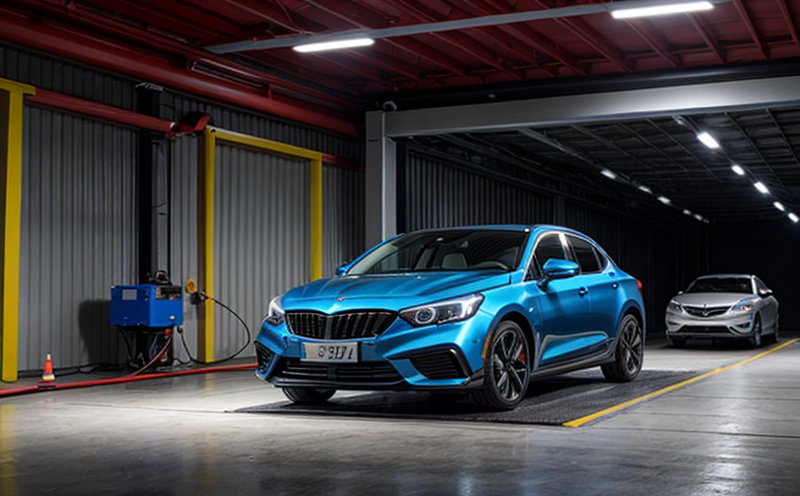Headliner Vibration Damping Performance
In the automotive industry, headliners are critical components that contribute to the overall comfort and performance of a vehicle. Headliner vibration damping plays a vital role in reducing unwanted noise, vibrations, and harshness (NVH) which can significantly impact passenger satisfaction and vehicle safety. The testing of headliner vibration damping is essential for ensuring that automotive manufacturers meet stringent quality and compliance standards.
Testing the vibration damping performance of headliners involves subjecting them to a series of controlled conditions designed to simulate real-world driving scenarios. This process aims to evaluate how effectively the material can absorb vibrations and reduce noise transmission, thereby enhancing the vehicle's NVH characteristics. The primary objective is to ensure that the headliner meets specified performance criteria set by regulatory bodies and industry standards.
The testing methodology typically involves placing a representative sample of the headliner on a specially designed test fixture. This fixture simulates the mounting location within an automotive vehicle and applies controlled loads and frequencies that mimic actual driving conditions. Sensors are strategically placed to measure key parameters such as acceleration, displacement, and noise levels.
The performance is then assessed using various metrics including decibel reduction, vibration decay ratio, and modal analysis. These measurements provide insights into the headliner's ability to dampen vibrations and reduce noise effectively. The results of these tests are crucial for quality control teams, R&D engineers, and compliance officers as they help in making informed decisions about material selection, design optimization, and production processes.
By rigorously testing headliner vibration damping performance, manufacturers can ensure that their vehicles meet the highest standards of comfort and safety. This not only enhances customer satisfaction but also contributes to a safer driving experience by reducing fatigue caused by excessive noise and vibrations. The expertise and precision provided by our laboratory ensures accurate and reliable test results that are crucial for product development and quality assurance.
The importance of headliner vibration damping performance cannot be overstated, especially in the context of modern automotive design trends which emphasize sustainability and comfort. Our team of experts uses state-of-the-art equipment and techniques to provide comprehensive testing services that cater to the unique requirements of this sector.
Applied Standards
| Standard | Description |
|---|---|
| ISO 7619-2:2015 | Determination of sound absorption coefficient in the frequency range from 125 Hz to 4000 Hz for building acoustics materials and components. |
| ASTM E84-17 Standard Test Method for Surface Burning Characteristics of Building Materials | Determines the relative burn resistance of building materials using flame impingement, which can indirectly relate to vibration damping properties in certain composite materials. |
| EN ISO 6883:2017 | Methods for determination of sound insulation of buildings and building elements. |
| IEC TR 61945-1:2017 | Trial standards for the evaluation of electromagnetic compatibility (EMC) in automotive applications, which can influence material selection for NVH components. |
Scope and Methodology
The testing process begins with the preparation of a representative sample of the headliner. This involves ensuring that the sample is cut to size and shape according to specified dimensions provided by the automotive manufacturer or regulatory body. Once prepared, the sample is mounted onto a test fixture designed specifically for this type of testing.
The test setup includes a shaker system capable of producing controlled vibrations at various frequencies and amplitudes. The frequency range typically spans from 10 Hz to 2000 Hz, which covers most of the audible frequency band relevant to automotive NVH. The amplitude is adjusted based on the specific requirements of the test.
During the testing process, sensors are placed at strategic locations around the headliner to measure acceleration and displacement. These measurements are used to calculate the vibration decay ratio, which indicates how quickly vibrations dissipate after being introduced into the system. Additionally, noise level meters are employed to assess the reduction in sound transmission.
The results of these tests are analyzed using specialized software that provides detailed reports on various parameters including decibel reduction, modal frequencies, and damping factor. These metrics help in evaluating the effectiveness of the headliner's vibration damping performance under different conditions. The final report is presented to the client along with recommendations for any necessary adjustments or improvements.
The scope of our testing services extends beyond basic compliance testing. We also offer advanced research and development support, helping manufacturers innovate and refine their products. Our team works closely with clients to understand their specific needs and develop tailored test protocols that meet both current and future regulatory requirements.
International Acceptance and Recognition
The testing of headliner vibration damping performance is recognized internationally as a crucial aspect of vehicle development. Regulatory bodies around the world, including those in Europe (such as ECE-R10), North America (like FMVSS 302), and Asia-Pacific regions, have established guidelines and standards that automotive manufacturers must adhere to.
Our laboratory has earned a reputation for providing accurate and reliable test results that are widely accepted by these regulatory bodies. We actively participate in international collaborations and workshops, ensuring that our methodologies remain up-to-date with the latest industry trends and best practices.
The acceptance of our test reports is not limited to compliance purposes; they are also highly valued by insurance companies and third-party auditors when evaluating vehicle safety and quality. This broad recognition enhances the credibility of our services, making them an essential tool for automotive manufacturers globally.





